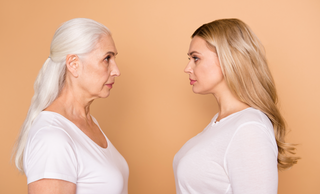Are you trying to look younger but have no idea where to start? Anti-aging might seem daunting, but it's a bit easier than you might think. There are armies of products online that swear by their anti-aging properties, but what do you really need for anti-aging to take place?
How Does Anti-Aging Work?
Whether you're visiting a dermatologist, applying anti-aging products, or performing DIY skincare, there's a few things going on underneath the surface that actually contribute to the reversal of aging:
- sealing in moisture
- eliminating free-radicals
- initiating cellular turnover
- boosting collagen
- destroying dead skin cells
It doesn't matter what product or method you're using, these are the major players in the anti-aging process. As we age past early adulthood, we begin to lose collagen at around 1% - 1.5% per year.
Skin loses resilience over time, but just this. It's ability to repair itself and regenerate skin cells is slowed.
What is Cellular Turnover?
You should be focusing on all of the items in the above bullets; achieving these leads to a well-rounded ability to fight signs of aging. But one that needs some attention is cellular turnover. This is a term not many are familiar with, but is a powerful anti-aging process. Learning how to stimulate this process is key to reversing aging and regaining your youth.
Cellular turnover, put simply, is "the continuous process of shedding dead skin cells and subsequently replacing them with younger cells".
Hinder your cellular turnover process and your skin begins to rebel. This includes fine lines, acne, hyperpigmentation, uneven skin texture, and more.
The Life Cycle of a Skin Cell
Every cell in your body has a life cycle that normally lasts about 28 days. New skin cells are born within the deepest layer of your dermis, called the basal layer. As they mature, they move upwards through the epidermis and toward the skin’s surface. At some point during this process, these cells lose their nuclei, meaning they're longer active, living cells. Having become a layer of dead cells, they slough off the surface.
When dead cells fall off, new ones rise to the surface to take their place. This process clears dull skin and gives you a more radiant complexion. These new cells are healthy, just born, and full of vitality and resilience.
Exfoliation Boosts Cellular Turnover
What ends up happening for some is dead cells detach from the skin and begin to pile up on top of each other. This means that without some proper assistance, there could be a thick layer of dead skin cells hindering your skin from being able to look more youthful.
Chemical exfoliants such as AHA’s interact with the bonds between the dead cells and the skin and helps loosen the cells to encourage them to fall off. Think Gin Amber Beauty's Natural AHA/BHA Exfoliating Cleanser. Not only does this assist cellular turnover and eradicate dead skin cells on the surface, but it evens out texture and paves the way for healthier, replenished skin.
Retinol, Retinol, Retinol
Retinol is a type of retinoid, which is made from vitamin A. While it does not remove dead skin cells itself, it speeds up the process of cellular turnover. As small molecules also go deep beneath the epidermis to your dermis and neutralize free radicals. This helps boost the production of elastin and collagen, which creates a “plumping” effect that can reduce the appearance of fine lines, wrinkles, and enlarged pores.
Finally, retinol has an exfoliating effect on the skin’s surface that can help improve texture and tone and has been proven to reduce inflammation and acne.
Microneedling
Microneedling is probably one of the greatest ways to encourage cellular turnover. As the needles penetrate the skin, circulation, collagen production, and cellular turnover all improve, thanks to the body's natural healing processes working to recover from the micro-wounds.
It's important to note that for beginner microneedlers and those with sensitive skin, it's best to start with a smaller needle size, preferably 0.25mm. As the weeks pass with consistency, consider moving up in needle size (0.5mm).
The Takeaway
In terms of anti-aging, cellular turnover matters because it has a significant influence on the aging process. The faster the cell turnover rate, the more youthful the appearance of the skin. It's that simple.
A faster turnover rate means your skin may respond better to certain external effects (such as sun damage) by replicating cells more efficiently and quickly.
Long story short, all skin types are improved by speeding and improving the quality of skin cell turnover. Wrinkles, hyperpigmentation, acne, dullness, and uneven texture and tone all brighten up and become smoother as cells are replaced by healthier ones.
I can't help but stress enough how learning a simple process like this can educate and reinforce skincare routines. Most of us don't know where to start when it comes to our anti-aging journey, but by understanding our bodies and skin's natural processes, we can come into the arena armed with knowledge and a clearer understanding of just how to regain our confidence, youthful appearance, and glowing complexion back.
Thank you Amber Babies for tuning into yet another blog post! Feel free to leave comments and questions and don't forget to visit me on IG, @ginamberx, where I go over remarkably effective skincare tips, trends, and topics!

Betty Clark
I use a high quality exfoliating vitamin C moisturizer twice a day.
My skin has improved immensely
in texture and brightness but at 60 I could benefit from some retinol and microneedling I’m sure. What serum or moisturizer would you reccomend I add for the microneedleing sessions and would I apply it right before, during or after the microneedleing?